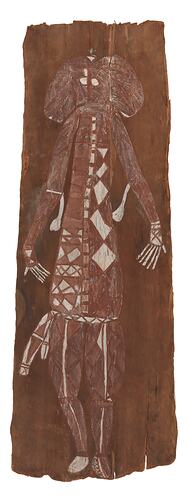Summary
Museums Victoria holds significant collections of artworks by Australian Aboriginal artists dating from the nineteenth and early twentieth centuries. This painting is from the large number of works commissioned after a visit to Oenpelli by the director of the National Museum of Victoria, Walter Baldwin Spencer in 1912. Oenpelli was a pastoral lease taken up in 1906 by the legendary Northern Territory figure Paddy Cahill, and when Spencer returned to Melbourne with thirty-eight works on bark that had been removed from the wet season shelters in the area of the East and South Alligator Rivers, he forwarded Cahill the sum of 99 pounds to make an extensive collection for the museum. The collaboration between these two men over the following decade would result in the commissioning of over 170 bark paintings for the museum, and close to a thousand cultural objects were also collected and forwarded to Melbourne. The imagery in the bark paintings derives from a vast array of animals that are depicted in the rich rock art of the region, as well as a significant number of spirit figures known to bining, the people of western Arnhem Land. The bark paintings in the Spencer Collection and the Paddy Cahill Collection are considered the most significant historical art works from western Arnhem Land, and often feature in national and international exhibitions and publications. These paintings take pride of place amongst the extensive and significant holdings of Aboriginal art in the Indigenous collections at Museums Victoria. The only earlier known bark paintings are in the Macleay Museum in Sydney and date from 1878 and were collected at Port Essington.
Physical Description
A single sheet of eucalyptus bark, stringybark (Eucalyptus tetrodonta), painted with natural pigments. The male figure has bags or baskets suspended from his elbows.
Significance
This spirit figure is identified by Cahill as 'Mununlimbi' and roams about in search of 'sugar bag' (honey). The baskets hanging from each elbow are for collecting the honey. The painting style here is somewhat conventional showing the front view of the figure and its prominent and distinctive head and hair. The face does not appear to include a mouth, and while the backbone and leg bones are evident it does not conform to the typical x-ray style of western Arnhem Land art practice. Typically these spirits are painted with additional and exaggerated digits on their hands and feet, and this one has an extra finger on each hand and no toes.
More Information
-
Object/Medium
Painting, bark
-
Maker
-
Cultural Groups
-
Locality
Oenpelli, Western Arnhem Land, Northern Territory, Australia
-
Date Produced
-
Collector
-
Date Collected
-
Object Measurements
1845 mm (Length), 830 mm (Width), 70 mm (Height)
-
Keywords
-
Collection Names
-
Type of item
-
Discipline
-
Category
-
Collecting Areas
Australian Indigenous - Northern Australia and Queensland and Torres Strait Islands
-
Medium
Natural pigments
-
Technique
Painting
-
Support
Eucalyptus bark
